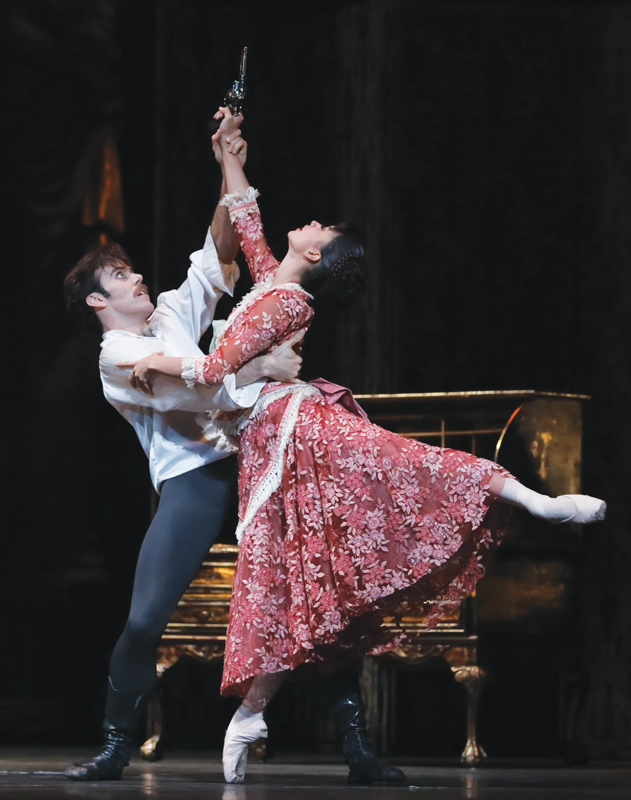Houston Ballet: Kenneth MacMillan / Mayerling - Vancouver Ballet Society
- Home
- Reviews 2014 - 2019
- Houston Ballet: Kenneth MacMillan / Mayerling

The cemetery at Heiligenkreuz before dawn: this is where Kenneth MacMillan’s narrative masterwork, Mayerling, begins and ends. A coffin lies upstage, rain pours down, and Bratfisch, a popular entertainer and cab driver for Crown Prince Rudolf of Austria-Hungary, droops in grief. The coffin is for Baroness Mary Vetsera, the young mistress of Rudolf, the caddish anti-hero who shot her and then himself in a double suicide pact at the hunting lodge at Mayerling. Theirs is a sordid but compelling tale, scripted by the late British choreographer in vivid anguished hues. Especially brilliant are a series of pas de deux between Rudolf and the several women in his unhappy life, danced by Houston Ballet with thrilling, often chilling, acrobatic abandon and emotional detail.
Houston Ballet’s September performances of Mayerling, which London’s Royal Ballet premiered in 1978, marks the first time the work has been danced by a North American company. MacMillan’s Gloria and Manon are already in the Houston repertoire; with the addition of Mayerling, artistic director Stanton Welch has given the men a meaty leading role to test their technical and interpretive mettle. There are also plenty of rich supporting roles.
The first cast’s Connor Walsh, the company’s stalwart male principal, etched his portrayal of Rudolf across the three-act evening with deep, incisive and convincing despair, arrogance and, at times, brutality. This Rudolf is drawn to his mother, Empress Elisabeth (Jessica Collado), with disturbing intensity, and is decidedly not interested in his bride, Princess Stephanie (Melody Mennite). The young woman’s terror during their wedding night pas de deux — when Rudolf sadistically brandishes the pistol and skull he keeps lying about — carried in every move of Mennite’s heartbreaking portrayal, finely tuned throughout every scene she is in. If their bedroom scenario sounds over the top, the ballet’s libretto is based on historical research.
Collado was fascinating as Empress Elisabeth. Her warm face drew us into her character, a vibrant mature woman negotiating difficult territory with a weirdly needy adult son. During their act one pas de deux, his ardour and her restraint tell a fascinating story of emotional damage. In the act two duet with her gentle lover (Ian Casady), Collado found the fullness of every musical phrase, as if wanting each romantic moment to last forever. Eerily, Rudolf watched and, at its end, his crabbed and stuttering solo was a disturbing portrayal of a tormented soul in a brave artistic rendering from Walsh.
As Mary Vetsera, Karina Gonzalez was liquid steel in the airborne lifts, and handled Rudolf’s pistol as if it were erotic foreplay. In the second cast, Mennite was softer, silkier, fascinated by Rudolf (elegant Charles-Louis Yoshiyama), but needing to find a way to join him in his torment.
A call-out must go to Sara Webb as Rudolf’s sophisticated ex-mistress, Marie Larisch, a manipulator finding ways into his life, if not his bed. Another goes to Yuriko Kajiya, as the high-class prostitute Mitzi Caspar. Kajiya’s Mitzi was a strong match for the four male soldiers with whom she shares an ensemble dance, as much a player as the played, at times with them step by step in refreshingly gender-free choreography, a welcome note of empowerment in this ballet of 19th-century royalty and whores.
John Lanchbery’s smooth arrangement of Franz Liszt compositions, played live by Houston Ballet Orchestra, added notes that ranged from sweet to epic. Set and costume design by Pablo Nuñez, created for the 2013 Chilean premiere by Ballet de Santiago, created an intimate sense of period ballrooms, boudoirs, taverns and streets.
Adding to the tension of the Houston premiere was having to move from home base at the Wortham Theater Center, due to damage from flooding during the recent catastrophic Hurricane Harvey that battered the city, to the Hobby Center for the Performing Arts, where only two of the planned three casts performed, and in only two performances each. Hopefully, the ballet will have a long life in the company’s repertoire. The narrative arc driving not just the whole piece, but also individual dances, demands every move carry a dramatic beat, and teasing out details of character and plot could keep dancers and audience members happy for years. The Hungarian separatist subplot, for instance, is obscure, though visible once you track it.
Finally, let’s return to Bratfisch, the sad-shouldered man who begins and ends the ballet, performed in both casts by soloist Christopher Gray. In his act two solo — during a tavern scene shared with a dozen prostitutes wearing garters and torn stockings — Gray is decked out in top hat, vest and burgundy tights, his nimble airborne configurations a delightful interlude from the evening’s heavy drama. Later, when Bratfisch brings Mary to Rudolf at Mayerling and trots out the same steps just for them, they have other things on their minds, and his lively dance carries a sycophantic, needy edge. Gray’s turn as the entertainer is as complex as every other role in this dark, very adult ballet.
— KAIJA PEPPER
DI WINTER 2017

